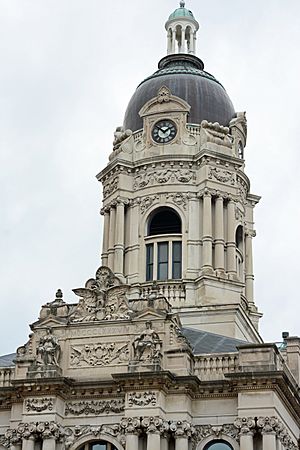Old Vanderburgh County Courthouse facts for kids
Quick facts for kids |
|
|
Old Vanderburgh County Courthouse
|
|
 |
|
| Location | Evansville, Indiana |
|---|---|
| Area | 2.2 acres (0.89 ha) |
| Built | 1888 – 1890 |
| Architect | Henry Wolters |
| Architectural style | Baroque |
| NRHP reference No. | 70000010 |
| Added to NRHP | September 4, 1970 |
The Old Vanderburgh County Courthouse, often called the "Old Courthouse," was once the main place for the Vanderburgh County, Indiana government. Building started in the spring of 1888 and finished in November 1890. The county government began using the building in early 1891. It is located right in the center of downtown Evansville.
Henry W. Wolters, an architect from Louisville, Kentucky, designed the building. It cost about $379,450 to build. This amazing 19th-century building takes up an entire city block. It is covered with cool sculptures and stone carvings made from Indiana limestone. Fourteen main statues were created by Franz Engelsmann. He was a German artist who studied with famous masters. The building also has carvings of local plants like vegetables, fruits, and flowers. These decorate the tops of the many columns around the building.
Before the courthouse was built, this spot was a basin for canal boats. Boats on the Wabash and Erie Canal would deliver goods here. They would then turn around for their trip back north. After railroads became popular, the canal was no longer used. The area was filled in, and the courthouse was built on top of it. A tunnel runs under Vine Street, connecting the Old Courthouse to the Old Vanderburgh County Jail.
Contents
Exploring the Old Courthouse Architecture
The Tall Tower
The bell tower of the Old Courthouse stands super tall at 216 feet (66 m). The bottom part of the tower has windows that let in sunlight. The next section is open and holds the huge 4,500-pound (2,000 kg) Old Courthouse bell. This bell was made by the McShane Bell Foundry in Baltimore, Maryland. It has been ringing at the courthouse since August 20, 1890.
Above the bell is a section that holds the clock's inner workings. The clock has four faces, one on each side of the building. Each clock face is 7.5 feet (2.3 m) wide! At the very top of the tower, there's a winding staircase. It leads to the copper-covered dome of the courthouse.
Court Street Entrance Details
Above the Court Street entrance, a large eagle with wide wings sits on a shield. This eagle is a symbol of the United States. Below the eagle, you can see large Roman numerals carved into the stone. They show the year construction began.
To the left of the entrance is the Goddess of Manufacturing and Industry. She holds a hammer and a cogwheel, which are symbols of factories and work. Next to her is a train, showing how important transportation was back then. To the right is the Goddess of Agriculture. She rests her hand on a plow and is surrounded by farm symbols. These include grain, vegetables, and a beehive. Above the arches of the doorway are two cherubs. The one on the left is female, holding a nest, showing care. The one on the right is male, holding a bow, showing hunting.
Fourth Street Entrance Details
High above the Fourth Street entrance, there are three statues. They are thought to represent the search for knowledge and truth. The middle statue wears a crown and holds a sword. To her left is the only male statue on the building. He rests his arm on books and holds a tablet. To the right of the central figure is a statue holding a torch and resting her arm on books too.
Below these statues is a carving of the Seal of the State of Indiana. It shows a forest scene with a hunter and a buffalo. Large oak leaves surround it, symbolizing importance. Above the doorway arches are two muses, or Greek goddesses. The one on the left holds a harp, representing music. The one on the right shows a palette, representing painting.
Fifth Street Entrance Details
Like the Fourth Street side, the Fifth Street entrance also has three statues above it. These statues are believed to represent justice. The middle figure holds the scales of justice and a staff. The meaning of the three raised fingers on her staff and the snake in her hair is not clear. The statue on the left holds a tablet. The statue on the right holds a torch.
Below these statues, you will again find the Seal of the State of Indiana. There are also muses above the doorway arches. The one on the left holds a mallet and a bust, representing sculpture. The one on the right holds a book, representing literature. The revolving door on the Fifth Street side is one of the oldest still used in Evansville, even though it wasn't there in 1890.
Vine Street Entrance Details
The Vine Street entrance has some things that are similar to the Court Street side. The American eagle is again at the top of this side of the building. The Roman numerals "1888" are also found below the eagle. However, the goddesses on this side are different from those on Court Street.
To the left, you'll see the Goddess of Commerce and River Trade. Her hand rests on the front of a boat, with a chain and anchor. She is surrounded by symbols of river trade from the late 1800s, like bales and barrels. To the right is the Goddess of Learning. She has scrolls at her feet and holds a tablet. Like on Court Street, there are cherubs above the doorway arches. They represent male and female figures. But their positions are switched, with the male on the left and the female on the right.


